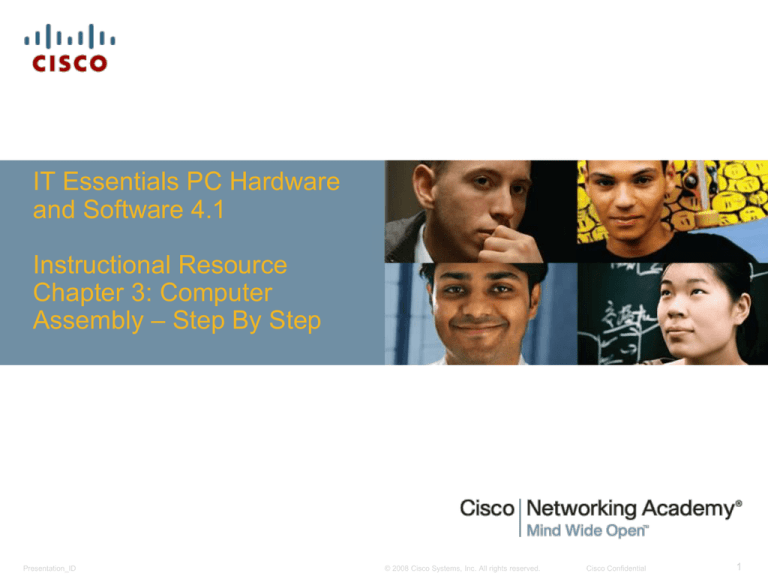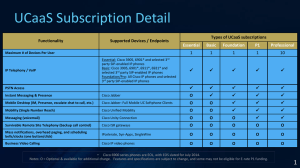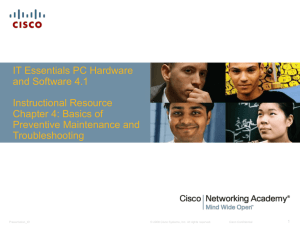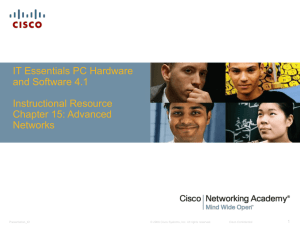
IT Essentials PC Hardware
and Software 4.1
Instructional Resource
Chapter 3: Computer
Assembly – Step By Step
Presentation_ID
© 2008 Cisco Systems, Inc. All rights reserved.
Cisco Confidential
1
Chapter 3: Objectives
Open the case.
Install the power supply.
Attach the components to the motherboard and install the motherboard.
Install internal drives.
Install drives in external bays.
Install adapter cards.
Connect all internal cables.
Re-attach the side panels and connect external cables to the computer.
Boot the computer for the first time.
Presentation_ID
© 2008 Cisco Systems, Inc. All rights reserved.
Cisco Confidential
2
Chapter 3: Critical Concepts
What is this chapter about and why is it important?
This chapter demonstrates the step-by-step procedure for assembling a desktop
computer. It provides detailed graphics showing the proper installation procedure for
each component of the computer. Where appropriate, this chapter explains other
methods of component installation. Hands-on labs allow the student to assemble a
computer with an emphasis on safe practices.
This chapter is important because it gives students the opportunity to learn about all
of the components of a desktop computer and has them assemble one in a lab. The
chapters and labs that follow Chapter 3 build on this basic knowledge of the
computer. For those students who do not have access to a physical desktop
computer in the lab, Chapter 3 also provides a Virtual Desktop. The Virtual Desktop
labs demonstrate desktop assembly through animation and student interaction.
Presentation_ID
© 2008 Cisco Systems, Inc. All rights reserved.
Cisco Confidential
3
Chapter 3: Activities
What activities are associated with this chapter?
3.2: Lab: Install the Power Supply
3.2 Optional Activity: Virtual Desktop – Power Supply
3.3.3: Lab: Install the Motherboard
3.3.3: Optional Activity: Virtual Desktop – Motherboard
3.4: Optional Activity: Virtual Desktop – Internal Drives
3.5.2: Lab: Install the Drives
3.5.2: Optional Activity: Virtual Desktop – Drives in External Bays
3.6.3: Lab: Install Adapter Cards
3.6.3: Optional Activity: Virtual Desktop – Adapter Cards
3.7.2: Lab: Install Internal Cables
3.7.2: Optional Activity: Virtual Desktop – Internal Cables
3.8.2: Lab: Complete the Computer Assembly
3.8.2: Optional Activity: Virtual Desktop – External Cables
3.9.2: Lab: Boot the Computer
Chapter 3 Quiz
Presentation_ID
© 2008 Cisco Systems, Inc. All rights reserved.
Cisco Confidential
4
Chapter 3: New Terms
What terms are introduced in this chapter?
Presentation_ID
AC power cord
3.8.2
Accelerated Graphics Port (AGP)
3.6.3
Advanced Technology Extended (ATX) power connector
3.7.1
boot
3.9
CMOS battery
3.9.2
Complementary Metal Oxide Semiconductor (CMOS)
3.9.2
floppy data cable
3.7.2
floppy drive cable
3.7.2
Power-On Self-Test (POST)
3.9
standoff
3.3.3
© 2008 Cisco Systems, Inc. All rights reserved.
Cisco Confidential
5
Chapter 3: Changes
What has changed from the previous version (4.0) of ITEPC?
No changes were made to this chapter.
Presentation_ID
© 2008 Cisco Systems, Inc. All rights reserved.
Cisco Confidential
6
Chapter 3: Classroom Management
Disassemble the computer in a step by step process, keeping the students
moving through the process together. For example, everyone takes the cover
off after the instructor has explained the problems associated with the case.
Then move on to the next part to be removed. Reassembly works best if you
allow the students to work at their own pace.
If disassembling the computer in teams, rotate to the next team member every
five minutes. The teacher might want to control the rotation to ensure hands-on
time for each student.
Students that finish quickly should help others troubleshoot issues.
Do an Internet search on the keywords how to build a computer and find good
and bad points to demonstrate in class.
Presentation_ID
© 2008 Cisco Systems, Inc. All rights reserved.
Cisco Confidential
7
Chapter 3: Teaching Analogies
Computer reassembly is like a jigsaw puzzle. All the pieces fit nicely together to
make a nice picture when done properly. You cannot force a puzzle piece or a
computer component into the wrong spot.
Presentation_ID
© 2008 Cisco Systems, Inc. All rights reserved.
Cisco Confidential
8
Chapter 3: Suggested Class Discussions
Presentation_ID
Describe something you have disassembled and the reassembly did not go
very well. Tell us what happened.
What do you do when you drop a screw?
What do you do if you have parts left over?
Why are BIOS beep codes and text messages important to a technician?
What is important about pin 1 on a cable or connector?
What happens when screws are too tight?
What kind of damage can ESD cause to computer components?
© 2008 Cisco Systems, Inc. All rights reserved.
Cisco Confidential
9
Chapter 3: Best Practices
Presentation_ID
Allow students to troubleshoot their own computer reassembly problems. Put
the student name(s) on computers that do not work and have them continue
troubleshooting the computer problems during the next class period.
Stress cleanliness in the work area by putting away tools and straightening
cables.
Keep broken equipment separated from components that work; have boxes
for each category if possible.
If the class time is limited, integrate chapters 3 and 4. Students do
preventive maintenance at the same time as disassembly/reassembly.
© 2008 Cisco Systems, Inc. All rights reserved.
Cisco Confidential
10
Presentation_ID
© 2008 Cisco Systems, Inc. All rights reserved.
Cisco Confidential
11
Presentation_ID
© 2008 Cisco Systems, Inc. All rights reserved.
Cisco Confidential
12










